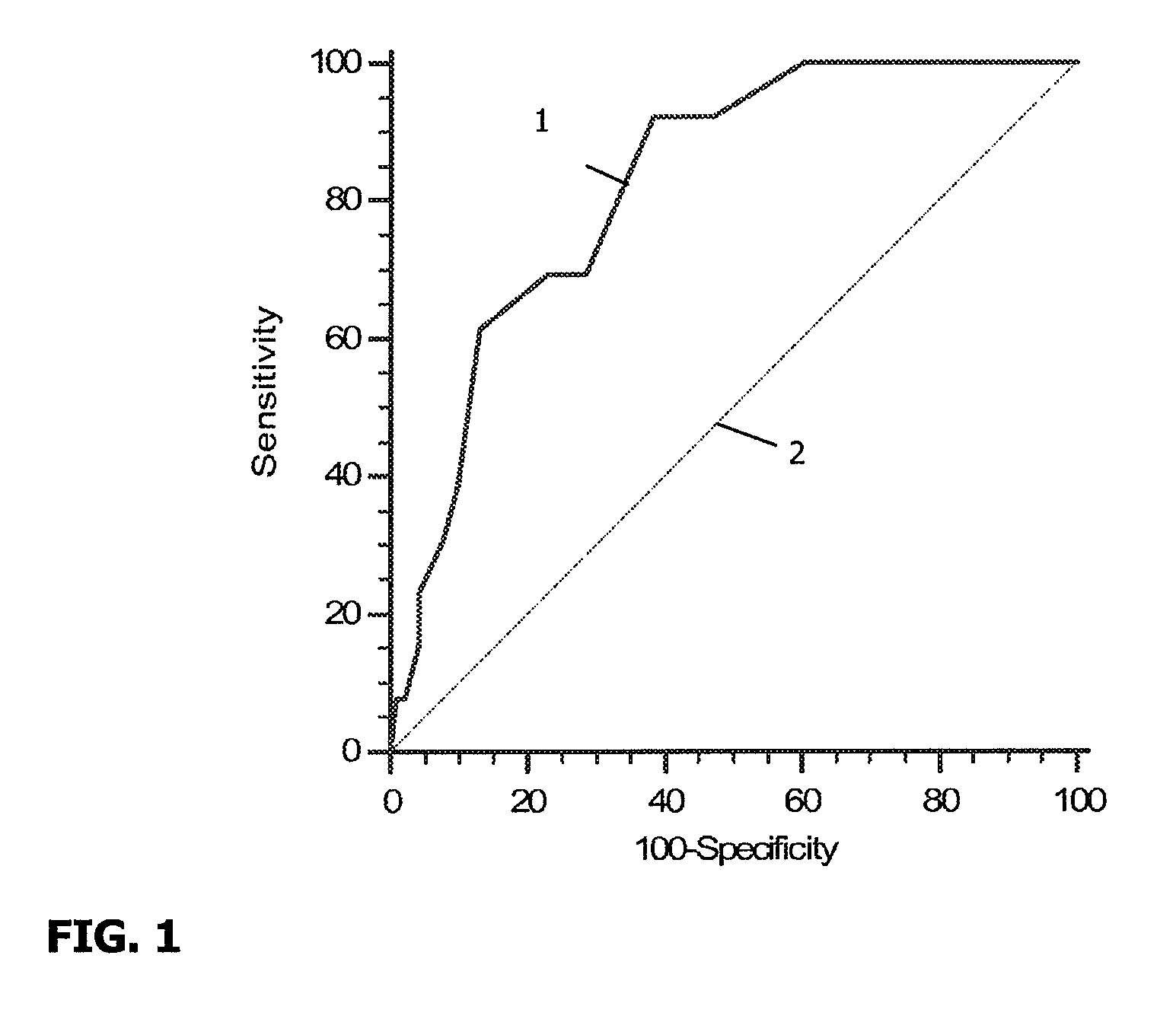Assay and kit for predicting implantation success in assisted fertilisation
a technology of assisted fertilisation and kit, which is applied in the direction of instruments, drug compositions, veterinary instruments, etc., can solve the problems of low implantation rate per transferred embryo, difficult and expensive procedures, and require interference with embryos, and achieve high implantation potential, high implantation potential, and high level of granulocyte-colony stimulating factor (g-csf)
- Summary
- Abstract
- Description
- Claims
- Application Information
AI Technical Summary
Benefits of technology
Problems solved by technology
Method used
Image
Examples
example 1
Experimental Design
Patients
[0073]280 female patients presenting with infertility and included in an ICSI program were recruited between January 2005 to March 2007. The reason for inclusion in ICSI was predominantly male infertility but also previous IVF failure or previous low fertilization rate in conventional IVF. We proceeded to a randomization at the time of inclusion to not introduce biases in the clinical patient selection. Each patient was included one time within the study period. All patients were fully informed, and the Institutional Review Board approved this investigation (Comité Consultatif de Protection des personnes Poissy-St germain en Laye,).
Pre-Treatment
[0074]Patients underwent the classical procedure of ovarian hyperstimulation. We applied the protocol referred by their physician. Response to stimulation was controlled by serial blood tests and ultrasonic evaluation to control follicles and endometrial growth. Criteria for triggering the ovulation was obtained whe...
example 2
Evaluation Using the Luminex Kit Manufactured by Biorad®
[0100]132 follicular fluid samples corresponding to the subsequent 132 transferred embryos were analysed for levels of certain cytokines and chemokines. In particular, concentrations of IL-1beta, IL-1Ra, IL-2, IL-4, IL-5, IL-6, IL-8, IL-9, IL-10, IL-12, IL-13, IL-15, IL-17, IFN alpha, TNF-alpha, G-CSF, GM-CSF, VEGF, PDGF, FGF, IP-10, MCP-1, RANTES, EOTAXIN, MIP-1 alpha, MIP-1 beta were evaluated using Luminex technology, utilising a a Biorad® Luminex® Kit.
[0101]The following results were obtained:
1) LIF, IL-1ra, IL-4, IL-6, IL-8, IL-10, IL-12, IL-13, G-CSF, VEGF, IP-10, MCP-1, Eotaxin and MIP-beta were detected in all the follicular fluid samples,
2) IL-1 beta, IL-5, IL-7, IL-17, TNF alpha, MIP-alpha were detected not detected in any follicular fluid sample,
3) IL-15, GM-CSF, Rantes, PDGF, IFN-gamma, IL-9, IL-2, IL-15, FGF were detected respectively in 95%, 94%, 88%, 81%, 76%, 65%, 60%, 48% and 22% of the follicular fluid samples...
example 3
Evaluation of Follicular Fluids Using the Luminex Kit Manufactured by R and D
[0112]200 follicular fluid samples corresponding to the subsequent 200 transferred embryos were analysed. The concentrations of the following cytokines and chemokines IL-1 alpha, IL-1beta, IL-1Ra, IL-2, IL-4, IL-5, IL-6, IL-8, IL-10, IL-17, IFN alpha, TNF-alpha, G-CSF, GM-CSF, MIP-1 alpha, MIP-1 beta, RANTES, MCP-1, VEGF, were evaluated using Luminex technology utilizing the kit made by R&D.
Detection of Cytokines and Chemokines
[0113]G-CSF, IL-1 Ra; IL-6, IL-8, MIP-beta, RANTES, MCP-1, VEGF were detected in 95 to 100% of the follicular fluid samples tested:[0114]IL-4, TNF-alpha, GM-CSF, IL-5 were detected in 75% to 94% of the follicular fluid samples tested,[0115]IL-1 alpha, IL-1 beta, IL-10, MIP-alpha were detected in 50 to 74% of the follicular fluid samples tested,
IL-2, IFN-gamma and IL-17 were detected in less than 50% of the follicular fluid samples tested.
Cytokines, Chemokines and Implantation Rates
[01...
PUM
| Property | Measurement | Unit |
|---|---|---|
| concentration | aaaaa | aaaaa |
| concentration | aaaaa | aaaaa |
| surface plasmon resonance | aaaaa | aaaaa |
Abstract
Description
Claims
Application Information
 Login to View More
Login to View More - R&D
- Intellectual Property
- Life Sciences
- Materials
- Tech Scout
- Unparalleled Data Quality
- Higher Quality Content
- 60% Fewer Hallucinations
Browse by: Latest US Patents, China's latest patents, Technical Efficacy Thesaurus, Application Domain, Technology Topic, Popular Technical Reports.
© 2025 PatSnap. All rights reserved.Legal|Privacy policy|Modern Slavery Act Transparency Statement|Sitemap|About US| Contact US: help@patsnap.com



